CoolGlide™ Laser Hair Reduction for Men and Women
Sonia Levingston, M.D, Internal Medicine in Oakland, California, is the Medical Director for the Laser Hair Reduction services of The Skin Studio’s Medical Division. We would also like to thank Eliot Battle, M.D., renowned dermatologist and Laser Researcher at Harvard University, for providing us the opportunity to train with him in Laser Hair reduction at Cultura Medical Aesthetics Spa in Washington, D.C.
With the introduction of the Altus CoolGlide™ laser for hair reduction, we finally can offer our clients a laser hair reduction treatment that offers the highest quality, safety, and effectiveness, at a reasonable cost for all skin types.
CoolGlide™ laser hair reduction is not only for "cosmetic" problems. Patients with excess hair due to medications (for example, organ transplant patients who are taking cyclosporine) can benefit from CoolGlide™ laser hair reduction. So can patients who have problems with ingrown hair or folliculitis.
Consultations about Altus CoolGlide laser hair reduction usually can be arranged within a week or two by calling 510 653-3355. Treatment sometimes can be done the same day as the consultation, or within a couple of weeks of the consultation.
Our staff, which has had Altus CoolGlide™ laser hair reduction, can take the time to discuss your wishes and options, and answer your questions. No referral is required.
Please call 510 653-3355 if you have any questions,
and to arrange for prompt, confidential laser consultation.
No referral is needed.
Laser Hair Reduction - Frequently Asked Questions
1. How does Altus CoolGlide" laser hair reduction work?
2. How is Altus CoolGlide" different from older laser systems?
3. Who is permitted to perform laser hair reduction?
4. What body
areas can be treated?
5. Are there
benefits to laser hair reduction compared to alternative treatments?
6. Are there
advantages over electrolysis?
7. What is
the cost?
8. What body
areas are most commonly treated?
9. Will my
insurance cover laser hair reduction?
10. May I
claim the cost of laser hair reduction as a tax-deductible medical expense?
11. Are there
risks associated with laser hair reduction?
12. Are laser hair treatment really "permanent"?
13. Can I
expect to be "hair free" in the treated area after the treatments?
14. How much
and how fast will hair grow back?
15. Why do you recommend at least 6 to 8 treatment sessions?
16. I have
had previous laser treatments and/or electrolysis. Is that a problem?
17. How do
I know if I am a good candidate for laser hair reduction?
18. Do certain
hair colors respond better to treatment?
19. Should
I consider any special questions when contemplating laser hair reduction?
20. I have
heard about Hirsutism and Hypertrichosis. What are these conditions?
21. How do
I obtain the best value from each treatment?
22. What
if I have moles, freckles and/or tattoos in the area to be treated?
23. What
is the procedure on the treatment day?
24. Does
laser hair reduction hurt?
25. What
happens after laser hair reduction treatment?
26. Why does
the hair sometimes look as though it's growing for 1-3 weeks after
treatment?
27. Should
I restrict my activities after treatment?
28. Must I discontinue any medication or skin care products before laser hair reduction?
Before and After
(All pictures are un-touched originals.)

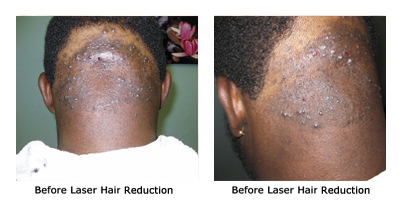
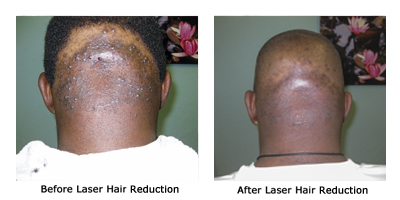
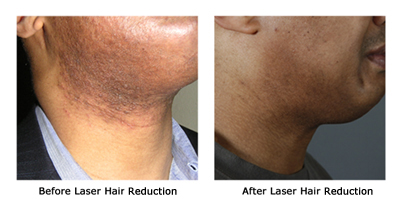
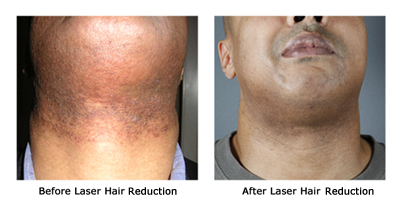
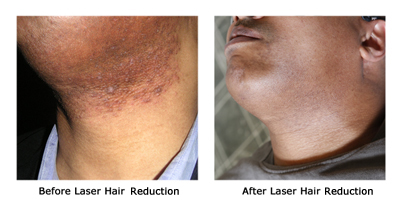
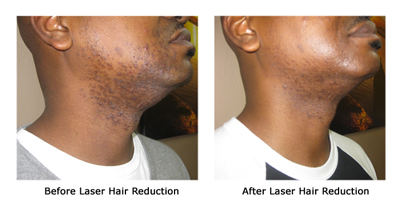
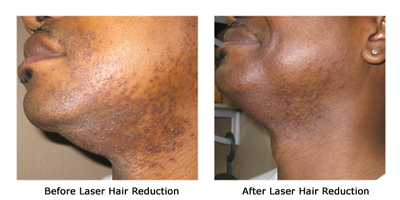
Because of gray hairs, client continues to have issues with folliculitis and discoloration in some areas.
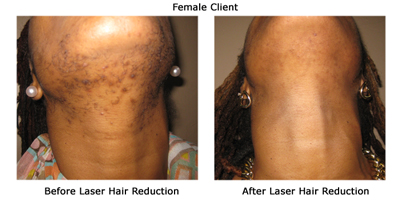
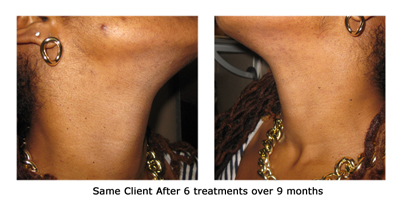
1. How does Altus CoolGlide™ laser hair reduction work?
The Altus CoolGlide™ laser is a non-invasive light therapy device that reduces hair from whatever parts of the body are desired. The Altus CoolGlide™ laser generates a pulse of intense, concentrated light, which is directed through a small hand piece, which is gently applied to the treatment site.
Laser energy passes through the skin to the hair follicle, where the energy is absorbed by pigment in the hair and hair follicle. This causes selective damage to the hair root without damaging delicate pores and other skin structures. The laser is pulsed for only a fraction of a second. The pulse duration is carefully determined so that laser energy will affect the hair follicle without transferring excessive heat to the surrounding skin.
Some of the hair in the treated follicles is immediately wiped off; the rest is shed over the next 2-3 weeks. The body reabsorbs the hair roots which are destroyed.
Cooling gel pads applied before and after treatment protect the skin surface, as does a gold plated cooling head which glides over the skin (CoolGlide™) half a second before the laser beam. This helps to protect the skin, while effectively treating the unwanted hair.
Unlike "hair-by-hair" treatments such as electrolysis, the laser uses a wide beam which treats many hairs at once. Because the Altus CoolGlide™ laser can treat dozens of hairs with each pulse, larger areas such as the back, shoulders, arms, legs and face can be treated effectively, and, compared to electrolysis, quickly. The Altus CoolGlide™ laser can be used almost anywhere on the body, and usually requires no anesthesia or other treatment. Even sensitive areas such as the nipples, upper lip and bikini line can be treated easily, with minimal discomfort.
The system's unique design allows us to customize treatment, according to your hair and skin color, hair texture, and the hairs’ location on the body.
Altus CoolGlide™ laser treatment is safe, fast, gentle and effective. In a few treatment sessions using the gentle power of lasers, you can improve the appearance of your skin by removing unwanted hair.
2. How is Altus CoolGlide™ different from older laser systems?
Other laser and intense pulsed light systems include:
• Second generation Alexandrite 755 nanometer (Epitouch ALEX, Photogenica LIPR, GentleLASE)
• Third generation Diode 800-810 nanometer (LightSheer, Apex)
These relatively short wavelength lasers can produce good results in some circumstances, but because they produce light which has a shorter wavelength, their laser energy both scatters more in the skin, and is mostly absorbed in the top few millimeters of the skin, above many of the hair roots. This means that sometimes not enough energy reaches the hair roots, where it is needed. These short wavelength, lower power systems are effective in some cases, but in other cases may only stun rather than destroy many of the hair roots and therefore sometimes cause temporary rather than more long term hair reduction. Short wavelength lasers can be difficult or impossible to safely use on people with dark, tanned or black skin.
By contrast, the Fourth Generation Altus CoolGlide™ laser uses the longest available, deeper penetrating 1064 nanometer wavelength. Altus CoolGlide™ reaches even the deepest hair roots, which can be 4-6 mm below the skin surface in some cases.
The long 1064 nanometer wavelength of the Altus CoolGlide™ makes it possible to safely and effectively treat all people -- even those with tanned, very dark or black skin.
CoolGlide™ allows the operator to adjust the duration of the pulse of laser energy to best suit the thickness of the hair shafts on different parts of your body. Some older laser systems lack this degree of fine control.
The gold plated ClearView™ cooling head on the CoolGlide laser provides an extra margin of safety and comfort, allows the operator a clear view of the area to be treated, and does not require pressure on your skin.
3. Who is permitted to perform laser hair reduction?
In the State of California, only a registered nurse (“RN”) or a medical doctor (“MD”) are allowed to perform laser hair reduction. Licensed aestheticians and/or cosmetologists, unless they are also an RN or an MD, are not permitted to perform laser treatments.
4. What body areas can be treated?
At The Skin Studio, most parts of the body CAN be treated (and ARE treated) with the Altus CoolGlide™ hair-removing laser. In women, the most common areas for treatment are upper lip, chin, bikini line, arms and legs, and underarms. In men, the most common areas for treatment are shoulders and back, and the beard area.
5. Are there benefits of laser hair reduction compared to alternative treatments?
The primary benefits of laser hair reduction include:
--Larger areas may be treated with less discomfort than with electrolysis,
waxing or tweezing.
-- The CoolGlide™ combines speed, comfort and long lasting results.
--The CoolGlide™ works on any area of the body where a hair-free appearance
is desired.
Shaving, waxing and depilatory creams remove the hair but leave the hair follicles intact, so the hair re-grows within one to four weeks in most cases. CoolGlide™ laser hair reduction offers a long-term reduction in both the amount of hair, and also in many cases a reduction in thickness and color of hair shafts which do grow back.
Plucking, waxing or sugaring cause irritation and may actually stimulate hair growth. This happens because one way the body defends itself against having hair pulled out is to produce thicker, stronger hairs which can be more difficult to remove over time.
Altus CoolGlide™ laser hair reduction offers long-lasting results. Even if hair does eventually grow back it is usually finer in texture and lighter in color than the original hair, and much less of a cosmetic problem.
6. Are there advantages over electrolysis?
With electrolysis, a needle is inserted into the hair follicle. The electrologist tries to reach the hair root with the needle tip. The electrologist then triggers a small electrical charge to disable the hair root. The hair from that follicle is then removed with tweezers. Thus, it could be said that removing hair by electrolysis is rather like mowing grass -- one blade at a time.
Nevertheless, electrolysis can be an excellent technique for
the reduction of:
• small numbers of hairs
• hairs from areas where it is difficult to use the laser (under the
eyebrows, near the eyes, and in the ears and nose.)
• white and very pale blonde hair (which does not absorb laser light
efficiently).
Clients are sometimes referred for electrolysis, and electrologists sometimes refer clients for laser hair reduction, depending on the needs and wishes of the client. For example, electrolysis can be useful for white or light colored hairs which do not respond to laser treatment, or if there are only a few dark hairs which need to be removed. Some people who have a mixture of dark and white hairs will have laser treatment to remove as many of the dark hairs as possible, then have electrolysis to remove any leftover white hairs.
Hair reduction is much faster with a laser because each "pulse" of laser light disables a large numbers of hair follicles, and pulses can be delivered as often as twice every second. Electrologists can only treat those hairs that they can see and which they can reach the follicle through the hair shaft. The Altus CoolGlide™ laser treats all "active" follicles, even if the hair has not yet reached the surface of the skin, is "ingrown", or if the hair shaft is not straight.
7. What is the cost?
The fee for pre-laser consultation is $50.00 for new clients. Cost for your treatment will be discussed at the time of consultation.
Treatment may be scheduled for the same day as the consultation if there is a time slot available, or may be scheduled for a later date.
8. What body areas are most commonly treated?
For Females
: Face, front of the neck, lips, under arms, bikini area,
legs.
For Males: chest, beard including
the front of the neck., back, back of the neck are the most commonly
treated areas. other areas can also be treated.
9. Will my insurance cover laser hair reduction?
We do not bill insurance companies for laser hair reduction. Most private insurance companies do not offer reimbursement for "cosmetic" procedures like laser hair reduction; however, consult your insurance carrier for more information. You will need to file the claim yourself if your insurance company does cover laser hair reduction.
10. May I claim the cost of laser hair reduction as a tax-deductible medical expense?
Generally you cannot include medical expenses paid for cosmetic surgery. This includes procedures such as face lifts, hair transplants, hair reduction, and liposuction. These expenses can be included if they are necessary to improve a deformity related to a congenital abnormality, a personal injury resulting from an accident or trauma, or a disfiguring disease. If you have questions about this, you should consult your certified public accountant.11. Are there risks associated with laser hair reduction?
Short-term side effects may include a slight reddening of the skin or local swelling which typically lasts less than an hour, although it may infrequently last a few days. Fourth generation, long wavelength 1064 lasers like CoolGlide™ are less likely than older lasers to cause prolonged irritation, pigment changes or blistering. Rarely (perhaps 2-4 cases out of a hundred) there can be increased or decreased pigment in the treated area. This is seldom a major cosmetic problem, and generally resolves after several months. Even a single blister (rather like a tiny sunburn) is very rare (less than one in a hundred).Unlike plucking, waxing and sugaring, laser hair reduction does not make hair grow back thicker, darker or quicker.
After Altus CoolGlide™ laser treatment hair growth will frequently be delayed, AND when hair does grow back, it is often lighter, finer and sparser.
12. Are laser hair treatment really "permanent"?
There is NO hair removal method (including laser), which can guarantee anyone "permanent hair removal". "Permanent hair REMOVAL" means: "ALL the hair is gone, FOREVER!"
The most realistic description of the results after laser treatment is: "long-term hair REDUCTION". This means: "After six to eight treatments the total amount of hair is greatly reduced -- generally by 70% to 80% -- and hair which does grow is often much finer and lighter in color." Most people are very pleased with this degree of improvement, as long as they know that this is what to expect before they have laser hair reduction treatment.
It is important for you to realize that after having between six to eight treatment sessions it is VERY LIKELY that there WILL BE a very substantial reduction in both the amount of hair and also a reduction in the thickness and color of the hair in the treated areas.
13. Can I expect to be "hair free" in the treated area after the treatments?
No, most patients experience an 70-80% reduction in the amount of hair in a given area, and a reduction in the thickness and color of the remaining hair, but should not expect to be "hair free".
It has been suggested that a 6 month follow-up may be sufficient to assess final outcome after the final laser hair reduction session, because once regrowth has stabilized (usually within 6 months), there is usually little or no change in hair counts at 6,12, and 24 months.
14. How much and how fast will hair grow back?
Hair regrowth may resume within a few weeks after the first treatment, or it may occur anywhere from 2-4 months. Previously dormant hair follicles eventually become active, and hair follicles which were stunned but not killed recover and start to produce hair shafts again. Some people find that there is not much extra hair reduction after the second treatment, and then they notice a substantial further reduction after the third or more commonly the fourth treatment. After six to eight treatments there may be little or no regrowth for many years. In other cases you may wish to have additional treatment after a period of time.
Hair fibers that regrow after laser treatment generally are finer and lighter in color, and so are much less of a cosmetic problem. Reductions in coarseness and color can occur independently of each other.
15. Why do you recommend at least 6 to 8 treatment sessions?
Lasers (and electrolysis, too), work by destroying hairs that are in their active growth cycle at the time of treatment. Hair follicles in their "dormant" phase have no hair shaft in them and so will not be affected by the laser. Because hair follicles cycle through "active" and "dormant" phases, additional sessions are usually desired once the "dormant" follicles become "active", and also to destroy hair follicles which were stunned but not killed by previous treatment.
Some hair follicles, which will produce dark terminal hair in the future, are called vellus, or fine “peach fuzz” follicles. As these have no pigment, they are not affected by laser treatment. When in the future these vellus follicles mature into terminal hair follicles, they can be treated with laser at that time.
NO treatment can kill 100% of the hair follicles, 100% of the time. Altus CoolGlide™ uses the longest, most deeply penetrating wavelength, and special cooling, to maximize the number of killed hair follicles and minimize the number that are stunned during each treatment session.
At any one time, 50 to 85% of your hair follicles are in the active (anagen) phase but only 1/4 to 1/3 of your hairs have enough of the pigment in their ROOTS to absorb the laser beam which destroys the hair root. So, about 1/4 to 1/3 of your hair roots are good targets for the laser beam, and can be damaged or destroyed in a single laser session.
Because 1/4 to 1/3 of the actively growing pigmented hair roots are damaged or destroyed in any one session, almost all clients should have a minimum of six to eight CoolGlide™ treatments to reach a satisfactory degree of hair reduction, and many people will wish to have more than six treatments, most commonly 6 to 8 treatments; and in some cases another session in six to twelve months to reduce any terminal hairs which have developed when vellus hair follicles mature into terminal hair follicles.
This will depend on:
--the desired degree of hair reduction (as the amount of hair declines,
some people become very enthusiastic and want even LESS hair than
they had originally planned on).
-- hair color (people with naturally light colored hair sometimes
need more treatments)
-- ethnic and genetic background (people with dark skin sometimes
need more treatments).
-- hormonal status
-- area being treated
-- hair density
-- age
-- weight (obesity can increase hair growth)
-- medication (for example medicines like Dilantin and cyclosporine
can increase hair growth)
Additional "touchup" treatments on discrete areas can be arranged at relatively low cost. There is no safety limit on the number of treatments a person can have. People who have been partially treated with other types of laser might in some cases need less CoolGlide™ laser treatments to reach a satisfactory degree of long-term hair reduction.
16. I’ve had previous laser treatments and/or electrolysis. Is that a problem?
Not at all. CoolGlide™ has been successfully used on many people who were not able to tolerate -- or did not obtain satisfactory results with -- electrolysis, or with older laser and "high intensity light" systems, including ruby laser, alexandrite laser, 800 nm lasers, and Epilight™ systems.
Depending on how much hair remains, people who have been partially treated with other lasers may need fewer treatments with the Altus CoolGlide™ to complete the process.
17. How do I know if I am a good candidate for laser hair reduction?
The unique design of the CoolGlide™ laser, and the long wavelength, allows treatment of people with all skin colors, and treatment of even light brown hair. Because hair which is naturally blonde, light red or white does not have enough pigment in the roots, it cannot be reliably treated with any type of laser. People who have black skin can be successfully treated with the Altus CoolGlide™.
Children can be treated if they have problems with excessive hair, but they must be old enough (approximately 12 years) to understand and cooperate with treatment.
CoolGlide™ laser hair reduction is not only for "cosmetic" problems. Patients with excess hair due to medications (for example, organ transplant patients who are taking cyclosporine) can benefit from CoolGlide™ laser hair reduction. So can patients who have problems with ingrown hair or folliculitis.
Some clients have fears and doubts before beginning laser hair reduction. A common concern is that they are being vain. Our experience has been that clients who seek laser hair reduction are no more vain than anyone else. What does distinguish them is a desire to get the most out of life. Looking after our appearance is not a fault. Normal, reasonable people who have realistic expectations tend to be excellent candidates for Altus CoolGlide™ laser hair reduction.
18. Do certain hair colors respond better to treatment?
Because lasers target the PIGMENT in hair roots, lasers work best on black or brown hair. Naturally red hair may require more treatment sessions and may respond only partially.
White hair does not respond to treatment!
19. Should I consider any special questions when contemplating laser hair reduction?
• How much are you bothered by your unwanted facial or body hair
• How much are you bothered by the time you spend removing, treating,
or concealing your unwanted hair?
• How uncomfortable does your facial or other unwanted hair make
you feel in exchanges of affection (such as intimate exchanges with
your partner)?
• How uncomfortable does your unwanted hair make you feel when
you meet new people?
• How uncomfortable does your unwanted hair make you feel when
you go to social gatherings, dine out in a public restaurant, go to
a supermarket or other public place?
• How uncomfortable does your unwanted hair make you feel when
you go to work or class?
20. I’ve heard about Hirsutism and Hypertrichosis. What are they?
Hirsutism is excessive growth of hair in androgen (testosterone)-dependent areas of a woman’s body where terminal hair is not normally found, including the face, neck, chest or medial thighs.Hypertrichosis is excessive growth of hair in non-androgen dependent parts of the body (i.e. Areas other than the face, neck, chest and medial thighs).
21. How do I obtain the best value from each treatment?
To get the best results with the smallest number of treatment sessions, please follow these simple guidelines:
A. Avoid waxing / sugaring / plucking / EpiLady and electrolysis
Because the laser beam seeks out and destroys ACTIVELY GROWING hair roots, it is important (if you want to get the best value from your treatment) NOT to wax / pluck / sugar / use EpiLady-type pluckers or have electrolysis for at least SIX WEEKS before laser treatment. These things temporarily remove the pigmented part of the hair follicle which the laser needs to use as a target when it destroys the hair follicle.
B. Avoid tanning!
Remember: there is no such thing as a “healthy tan!”
When skin colors up (turns pink, red, or “tan”) after sun exposure, it is a sign that it has been damaged by ultraviolet (UVA and UVB) rays. Even skin with more protective melanin is damaged by exposure to the sun. For the sake of your skin, when in the sun, cover up and use sunscreen.
CoolGlide™ is the safest and most effective laser for ALL types of skin, even black skin which cannot be safely treated with other hair reducing lasers. Many African-Americans, Africans, Italians, Greeks, and East Asians have been successfully treated with the CoolGlide™ lase.
It is also a good idea to avoid sun exposure -- at the very least, minimize tanning --for a few weeks after laser treatment, to reduce the chance that your tan will be somewhat uneven.
Use a sunblock that screens for both UVA and UVB with an SPF of 15 or higher.
C. Shave or clip the hair to be treated.
We recommend shaving the areas to be treated the night before treatment.
Another advantage of shaving the area to be treated BEFORE you come
in is that YOU can shape the area to be treated exactly the way YOU
want it to be. This is of particular importance in areas like the
sideburns, temples, and bikini line / bikini area.
Remove excess hair from the treatment area before CoolGlide™ treatment, because hair ABOVE the surface of the skin will simply absorb and waste laser energy and keep it from getting to the hair roots, where it is needed. There may be a small extra charge if we have to shave extensive areas before starting laser treatment.
Please do shave before treatment, and between treatments!
D. Hair Dye and Bleaching is not a problem.
Because the laser beam only acts on the hair ROOTS, you may dye and/or
perm hair in the areas to be treated. Likewise, it is fine to bleach
hair in the areas to be treated because bleaching will not affect
the color of the roots.
E. Timing:
Hair roots take 6 to 12 weeks to become active and develop pigment
which is the target for the laser. To maximize the value of your CoolGlide™
treatments, wait 6-8 weeks between treatments, in some cases some individuals may be treated within 4 weeks.
There is no harm in having CoolGlide™ treatments MORE FREQUENTLY than every 6 weeks, or having CoolGlide™ treatments less than 6 weeks after waxing, plucking, etc. -- but this is less efficient, and could increase the total number of treatments needed to get a good result.
F. Medications:
We will discuss medication concerns during your consultation. You may be required to have a physician's referral if you are on certain types of medications.
Hair-growth inhibiting medications (e.g. spironolactone/Aldactone tablets or Vaniqa cream) might slightly reduce the pigment in hair roots and one may require more treatments. Altus CoolGlide™ laser hair reduction can be done WHILE you are on those medications. These "anti-androgenic" medicines produce gradual but temporary effects, and will not remove unwanted hair from areas that are independent of androgen regulation.
Pretreatment with antiviral medications is recommended if you have ever had a cold sore, fever blister or herpes simplex on or near the area treated with the laser. Please let us know your medical history.
22. What if I have moles, freckles and/or tattoos in the area to be treated?
Small moles and freckles do not require any special precautions. Large, dark moles and freckles which are to be treated may require a reduction in the intensity of the laser light, the same way that the intensity would be reduced when treating a dark-skinned or tanned person. We do not treat tattoed areas. Be sure to tell us if you have permanent lip liner or permanent eyebrow liner, because these are tattoos and special precautions may be needed if there will be laser treatment near these areas.
23. What is the procedure on the treatment day?
Please stop all irritating skin care products 4 days prior to treatment (some products may require longer time). Please inform us of all medications and skin care products that you are currently using. Other than your regular skin care routine, there is no standard "prep" for this procedure. Please remove makeup before coming in for treatment. You may reapply makeup after treatment, if you wish. There are no restrictions on what you may eat or drink prior to your appointment.Shave or clip only the areas to be treated the night before you come in for treatment. Freshly shaved skin -- the day of treatment -- is more sensitive. Shaving allows you to shape the exact area you want treated -- this can be very useful in the bikini area. Excess hair above the surface of the skin absorbs and wastes laser energy, and reduces the amount of energy that reaches the hair root, where it is really needed. Excess hair above the surface of the skin also increases the chance of burning or irritating the skin.
When you come for treatment, do not wear any makeup because makeup can sometimes absorb laser energy. This could interfere with treatment, or even cause overheating of the skin surface and burning. Makeup can be applied immediately after Altus CoolGlide™ laser treatment, if you wish.
After any remaining questions have been answered and paperwork completed, the areas to be treated will be cleansed and pre-treatment photos may be taken. Everyone in the treatment room must wear protective goggles when the laser is turned on. The Altus CoolGlide™ is a high-powered laser system, and can cause eye injury if protective eyewear is not worn while the laser is used.
The length of the laser treatment itself can range from a few
minutes for the upper lip to an hour or more (for example, a man’s
chest and back).
If you decide before coming in that you would like to have additional
areas treated, please call ahead so that we can schedule enough time
to accommodate your needs.
Cooling pads may be applied to the skin for a few moments before the area is treated. Immediately before the laser is used on an area, the cooling pad is removed and a thin coat of clear gel is smoothed over the skin, then our carefully trained registered nurse quickly and evenly applies the laser pulses.
A friend or family member may accompany you if you like -- mothers and daughters often come in together for laser treatment. If you want to let the person with you watch your treatment, that person must wear the special laser goggles to prevent laser light from affecting the eyes.
24. Does laser hair reduction hurt?
The laser emits only light. You may feel a tingling or snapping sensation like a rubber band. There is no bleeding; no open wound is created. Some people find the FIRST laser treatment more uncomfortable than subsequent treatments. Perhaps this is the result of more hair roots being destroyed during the first treatment. Perhaps, too, some people are more apprehensive during the first treatment because they are unsure of what to expect.
Many patients find that they have less discomfort if they shave the area to be treated the night BEFORE coming in for treatment, because freshly shaved skin is often somewhat more sensitive. Shaving before coming in for treatment also allows you to shape the area to be treated exactly the way YOU want it. This is of particular importance in areas like the forehead, sideburns and bikini/pubic hair areas.
While some areas of the body like the upper lip and pubic hair area are more sensitive than others, many patients report little or no discomfort. If there is unusual discomfort, please let us know so that we can apply more cooling or adjust the settings on the laser.
People who have had waxing, sugaring, and/or electrolysis (or treatment with other lasers) usually report that CoolGlide™ causes less discomfort, and sometimes there is almost no discomfort.
The Altus CoolGlide’s™ long wavelength delivers more energy into the deeper part of the skin where the hair roots are -- and wastes less energy in the top 2 millimeters of the skin where many of the nerve endings are. This results in less discomfort than with other laser treatments.
Cooling gel pads are usually applied immediately before and after treatment, and soothing gel is used during the procedure. In addition, the CoolGlide™ laser can reduce the frequency of pulses and increase the cooling time in sensitive areas, to maximize your comfort.
It may be helpful to take two or three plain Tylenol and/or Advil a couple of hours before coming in for treatment. Some women find that they are less sensitive after their menses, and prefer to schedule their treatment sessions to avoid the premenstrual and menstrual time.
25. What happens after laser hair reduction treatment?
Any redness usually has faded greatly by the time you arrive home. The skin might be slightly drier that evening. We will discuss the usage of your skin care products and medications at the time of your treatment. Post laser instructions will be given to you prior to your treatment.
The hair follicles may appear slightly more prominent or a bit pink for the next day or two. This is seldom a cosmetic problem, and generally much less obvious than after waxing or sugaring.
26. Why does the hair sometimes look as though it's “growing” for 1-3 weeks after laser treatment?
Lasers destroy hair roots which are active at the time of treatment, but do not remove hair shafts instantly. Hair shafts in the treated hair follicles will fall out, or will "shed" mostly in the first week after treatment. All of the treated hairs will fall out within 2-3 weeks.
It is normal that some hairs in the treated area may not fall out within 2-3 weeks. These will be treated in the next session.
Hairs being shed fall out naturally. Do not shave the treated area or wash it with anything but a gentle cleanser and your bare hands (no Buf-Pufs, washcloths or Body Washes) for 3-4 days after laser treatment to avoid possible irritation. (Post laser instructions will be given to you prior to your treatment.).
27. Should I restrict my activities after treatment?
You can return to work the same day and resume all your usual activities immediately. Because the laser does not burn or cut the skin in any way, no bandages are necessary. To reduce the chance of uneven tanning in the treated areas, minimize sun exposure and tanning for a week or two after treatment.
Resume shaving or clipping hair in the treated area after 3-4 days. You should AVOID waxing / sugaring / plucking or electrolysis, because these activities will temporarily remove pigmented hairs from the hair roots and reduce the effectiveness of your next laser treatment. After plucking, waxing or sugaring, frequently the hair becomes thicker and darker, because one of the ways that the body defends itself from chronic irritation is to produce thicker, darker hairs.
Shaving really is the BEST temporary way to remove unwanted hair
before laser treatment, and between laser treatments. Shaving leaves
the hair SHAFT in the hair follicle, so the hair shaft can be a target
for laser energy, heat up and KILL the hair follicle.
28. Must I discontinue any medication or skin care products before laser hair reduction?
Please stop all irritating skin care products 4 days prior to treatment (some products may require longer time). Please inform us of all medications and skin care products that you are currently using. Other than your regular skin care routine, there is no standard "prep" for this procedure. Please remove makeup before coming in for treatment. You may reapply makeup after treatment, if you wish. There are no restrictions on what you may eat or drink prior to your appointment.